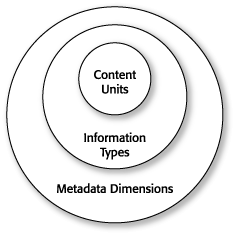WebReference.com - Chapter 4 from Content Management for Dynamic Web Delivery. (2/5)
[previous] [next] |
Content Management for Dynamic Web Delivery
What is an Information Model?
An Information Model is an organizational framework that you use to categorize your information resources. The framework assists authors and users in finding what they need, even if their needs are significantly different and personal. The framework provides the basis on which you base your publishing architecture, including print and electronic information delivery.
An Information Model might encompass the information resources of one part of an organization. For example, your Information Model might provide a framework for categorizing your corporate training materials or the technical and sales information that accompanies your products. Your Information Model might include engineering information produced during product development, policies and procedures used internally in the day-to-day conduct of business, information about customers used in your sales cycle or about vendors used in your supply chain. Some of the information resources you bring under content management might be available across the corporation for internal use, such as human-resources information. Other information resources might be specific to the needs of one department or division of your organization.

If an Information Model is clearly defined and firmly established, users will be on a fast
track finding and retrieving the information they need.
As you plan what to include under content management and what to exclude, you must consider a wide range of dimensions through which you will categorize and label your information. Some of the dimensions will be specific to the needs of information authors. Others will meet the requirements of your products and services. Still others will explicitly meet the needs of internal and external users of information.
As you design your Information Model, consider how large an information body it must encompass. Some Information Models are very small, specific, and limited in scope. Others stretch across entire organizations, encompassing thousands or millions of pages. In the next section, you start with a small, personal Information Model. In subsequent sections, you consider larger, more complex models for larger bodies of information.
The three-tiered structure of an Information Model
The Information Model you build will have a three-tiered structure. At base, the first tier of the Information Model consists of the dimensions that identify how your information will be categorized and labeled for both internal and external use in your organization. The second tier sorts your information assets into information types. The third tier provides structure for each information type, outlining the content units that authors use to build information types. Figure 4-1 illustrates the three-tiered structure. In this chapter, you learn how to determine the basic dimensions of your Information Model. In Chapter 5, Developing Information Types and Content Units, you learn how to identify your information types. And, in Chapter 6, Using Content Units to Structure Information Types, you learn how to identify the content units that provide the internal structure for each information type.

Figure 4-1: The three-tiered structure of an Information Model
The dimensions you identify as the foundation of your Information Model become the attributes and values of the metadata you will use to label your modules of content in your repository. The information types will provide your authors with the basis for creating well-structured modules that represent a particular purpose in communicating information. The content units will describe the chunks of content that are used to construct each information type.
In the next section, you will look at an extended example of the process one might use to begin the development of an Information Model. Throughout the core design Chapters 4, 5, and 6, I refer to this extended example to provide you with a model for developing the Information Model for your organization.
[previous] [next] |
Created: February 6, 2002
Revised: February 6, 2002
URL: https://webreference.com/programming/authoring/languages/html/dynamic/chap4/2.html


 Find a programming school near you
Find a programming school near you